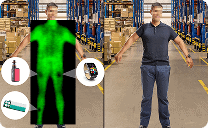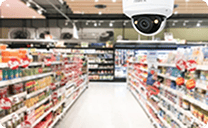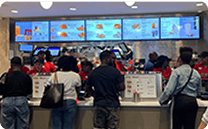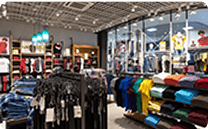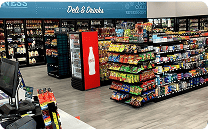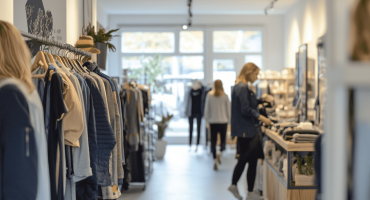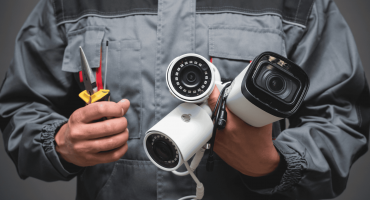In This article
Retail stores remain prime targets for shoplifting, theft, fraud, organized retail crime, vandalism, and other destructive incidents. The experts in store security systems have risen to the challenge with advanced security systems and other innovative retail safety solutions. Combined with employee training and ownership commitment, these technologies protect employees, customers, and tangible and intangible assets. From AI-powered surveillance cameras and monitoring systems to sophisticated inventory tracking technology, retailers have more choices to create store security systems that safeguard everyone and everything.
The Increasing Need for Advanced Security in Retail
Although there are some inconsistencies in the studies about retail crime rates, the consensus is that retail crime costs U.S. retailers tens of billions of dollars annually. Identifying and recording retail crime accurately is difficult. The Bureau of Justice Statistics in the U.S. Department of Justice reported in 2023 that approximately 75% of all thefts are undocumented. Many stores still need advanced security in retail.
Retail security has improved significantly, but too many stores still have security gaps. The statistics show that criminals, employees, and suppliers, in some cases, are penetrating those gaps. What exists through those gaps are retailers’ profits, customer trust, and employee loyalty.
- Shoplifting increased 24% on average in 23 U.S. metro areas in 2023. (Council on Criminal Justice)
- 13% of small business owners reported in 2023 that retail theft occurred every day in their stores. (Statista)
- “50% of associates have witnessed a theft or attempted theft.” (Axonify)
- A majority (58%) of organized retail crime is cargo theft, while 38% is in-store smash-and-grabs. (CapitalOne)
Core Components of Effective Store Security Systems
Most core components remain the same, except that the continual introduction of new, innovative technologies has made them more effective store security systems. Retailers have a greater array of security solutions than years ago, but the core components still do most of the job, only better.
- Video surveillance cameras will always be a frontline core component. With the development of 360-degree and AI-powered security cameras, retailers and their employees have a sharper, more total view of the shopping floor, backroom, and office.
- AI has also enhanced monitoring of what security cameras see to identify and thwart shoplifting and other retail crimes quickly and safely.
- Access-control systems are another critical core component. Keycards, biometric authentication, restricted entry areas, and other security solutions provide another layer of protection for retailers, especially those selling high-priced items like jewelry.
- Alarm systems have also advanced. They can detect intrusions and other incidents and have emergency response mechanisms so security personnel or employees can respond immediately.
- To combat shrinkage and control inventory better, retailers rely on RFID and barcode technologies, which continue to evolve.
Innovative Retail Security Technologies
Artificial intelligence (AI) and machine learning (ML) are driving innovations in retail security technologies. These technologies, particularly AI, have revolutionized store security systems, enabling them to simulate human intelligence, learn from data, reason, solve problems, and perform semi-autonomous security tasks.
- AI security cameras have enhanced object, facial recognition, and motion detection capabilities. They can learn from what they see to conduct behavior analysis to distinguish between actual security incidents and everyday actions and movements.
- Smart sensors have a myriad of uses to improve store security systems. Smart shelves can notify employees of the removal of an item so they can monitor customer behavior.
- IoT (Internet of Things) technology tracks inventory from the supplier to the store in real time.
- As innovations increase the capabilities of store security systems, more data is gathered, requiring cloud-based storage and retrieval. These cloud-based security platforms allow remote monitoring of sensitive data and immediately alert security personnel to vulnerabilities.
Implementation Best Practices
When carefully planned and implemented, store security systems provide a sense of safety and security for retailers, their assets, customers, and employees. Otherwise, time and money could be wasted, the return on investment (ROI) may be less than anticipated, and employees may not be prepared for their security responsibilities. But with a well-implemented system, there is a reassurance that everyone is protected.
- Before implementing a store security plan and system, smart retailers will conduct a risk assessment to determine where they may be vulnerable to the many threats in the retail environment.
- A store’s size and layout are also critical criteria for identifying security gaps and choosing and implementing the best configuration of security solutions: cameras, monitoring, data recording equipment, data analysis software, cloud storage, and other deterrents.
- Implementing a comprehensive employee training program is crucial to the success of a store security system. Employees play a vital role in maximizing the value of the system, as they are the ones who must identify and manage security situations effectively.
Measuring ROI and Effectiveness
A retailer’s investment in and the effectiveness of a store security system, even with the most advanced equipment and technologies, must be measured according to the appropriate key performance indicators (KPI). Only then can a retailer know their investment dollars are being applied correctly and are achieving pre-determined goals, such as reduced shrinkage and fraud, and customers and employees who feel safe and secure.
- There are many KPIs, but some of the most important are loss prevention (shrinkage/net sales X 100); security incidents per period (hour, daily, etc.); mean time to detect (MTTD) and mean time to respond (MTTR); and false alarms.
- Regular evaluation of security management is essential to ensure a store’s security system’s effectiveness and achieve ROI goals. While monthly or quarterly assessments provide an immediate picture, analyzing and comparing several years of data offers a more precise indication of the system’s ROI.
- Data can reveal one aspect of a store security system’s effectiveness and achieving ROI goals, but customer and employee feedback are equally important. Because employees are on the frontline of store security, they are more likely to identify gaps and new vulnerabilities while customers are focused on enjoying a safe shopping experience.
Future Outlook: The Evolution of Store Security Systems
The digital age has significantly boosted advancements in store security equipment and systems. Of all the new technologies, artificial intelligence (AI) and machine learning have greatly improved store security.
- AI-powered security cameras see better and are so well integrated with monitoring devices and an entire store security system that many security tasks are automated. Plus, they can recognize and analyze the behaviors of customers, employees, and suppliers based on what the algorithms have learned from past video data.
- With the increasing number of cybercrime incidents, retailers are well served by the inclusion of cybersecurity measures in their security protocols. These include firewalls, antivirus software, encryption, and other tools to protect sensitive customer and employee data and thwart cyberattacks that could devastate small business owners.
- The customer experience is a major differentiator in a competitive retail industry, so store security systems are evolving to improve the customer experience. With AI and machine learning, retailers better understand their customers and buying patterns. That data and customer feedback in surveys can be integrated into store security systems to maximize customer loyalty and spending.
Conclusion
Retailing remains a highly attractive, sustainable, and profitable business model because of many factors. However, innovative store security systems with the latest technologies are the most critical factors in today’s world. The record is clear for retailers with outdated or inadequate store security systems, creating many vulnerabilities that negatively affect the bottom line.
Although there have been many innovations in store security systems, AI and machine learning are arguably the most important advancements and solutions. While shrinkage from shoplifting, fraud, and other causes continues to plague many stores, new vulnerabilities, such as cybercrime, and more sophisticated retail organized crime tactics require wise investments in the most modern store security systems. To learn more about DTiQ’s range of security solutions and services, visit our website.
Meta description for WP
Explore how modern store security systems—powered by AI, IoT, and cloud tech—help retailers prevent theft, reduce shrinkage, and enhance customer and employee safety
